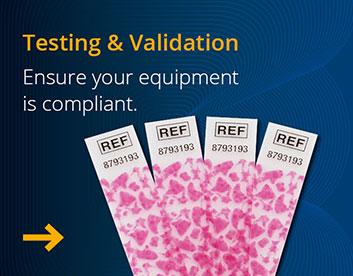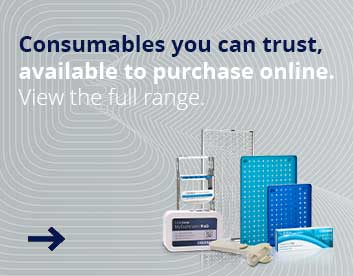The Eschmann Guide to Autoclaves
Welcome to the Eschmann guide to all-things-autoclave. Below is information on everything from
knowing the types of autoclave and the differences between them, to understanding which model
might be right for you.
The 'B' type autoclave, also known as a vacuum autoclave, uses a vacuum pump to remove air from the chamber to allow steam to effectively penetrate the load. This continues until the appropriate pressure and temperature is achieved to sterilise the items. Once sterilisation is complete, the exhaust valve opens to release the steam and reduce the pressure. The vacuum pump then removes the moisture in the chamber to dry the products, which are then ready for immediate use or to be put into storage.
Note: pouched instruments can be stored for up to one year.
All Eschmann 'B' type autoclaves can perform both 'B' and 'N' type cycles. To view our full range of 'B' type, vacuum autoclaves, click here.
The 'N' type autoclave is a non-vacuum option that generates steam from a boiler or generator. It uses displacement to push air from the chamber and achieve the required pressure and temperature for sterilisation.
The drying phase requires an aeration pump or the autoclave door can be opened on some models. Instruments can be used immediately or placed in a sealable pouch for storage (for up to one year).
To view our full range of 'N' type, non-vacuum autoclaves, click here.
The 'B' type autoclave is ideal for sterilising solid, porous items and hollow instruments – either wrapped or unwrapped.
The 'N' type autoclave is suitable for the sterilisation of solid, unwrapped instruments.
There are different sizes of chambers available in both categories, so it’s important to make sure you select the most appropriate autoclave for your needs.
To view our full range autoclaves, click here.
Regular in-house testing is essential to make sure that your autoclave is working correctly and consistently achieving the correct conditions for effective sterilisation of your instruments. These tests must be performed regularly (daily, weekly and annual tests) and the results recorded to demonstrate the efficacy of your infection control procedures.
Validation is another way of ensuring your equipment is working as it should. Professional validation is a requirement for compliance. It also offers further peace of mind that the autoclave is functioning safely.
In addition, both testing and validation will help to prolong the life of your equipment, minimise the risk of a malfunction and maximise the return on your investment.
Got a question or need help? Eschmann engineers are highly trained and experienced in ensuring the safety and efficiency of our equipment – Contact us for more information.
There are several areas you need to be aware of in order to maintain compliance with your autoclave(s) and associated infection control processes.
(Dental) HTM 01-05 and SDCEP require:
- All sterilisers, ultrasonic baths and washer disinfectors to be periodically tested, validated, maintained and serviced
- Documentation to be available for inspection of every sterilisation cycle, including details of the temperature and pressure achieved and the time taken
- Hard copy records to be kept in the steriliser log book
Other requirements to ensure compliance in preparation for inspection for all sectors include:
- Pressure Systems Safety Regulations (PSSR) 2000 Written Scheme of Examination
- Provision and Use of Work Equipment Regulations (PUWER) 1992
It is also important that all relevant staff have been adequately trained to operate and test the autoclave(s) safely and effectively. Evidence of this training must be retained by the practice to present on inspection, showing each individuals’ CPD training in decontamination and infection control.
Got a question or need help? Eschmann engineers are highly trained and experienced in ensuring the safety and efficiency of our equipment – Contact us for more information.
The Pressure Systems Safety Regulations (PSSR) are designed to minimise potential health and safety risks from the malfunction or failure of a pressure system or its components.
Compliance with the PSSR is a legal requirement for all businesses that have relevant equipment on the premises, including – but not limited to – dental practices, aesthetic clinics, veterinary practices, hospitals and other healthcare facilities. Pressure systems include any equipment that contains one or more rigid pressure vessel, pipework to which transportable pressure receptables can be connected or pipelines with protective device. The regulations extend to mandate monitoring and maintenance of relevant fluids as well, such as steam generated at high pressure or compressed gases. Some of the equipment that must be PSSR compliant are boilers, autoclaves, air compressors and more.
It is the responsibility of any workplace with pressure systems to ensure the safety of the equipment through testing, monitoring, maintenance, and annual examination. The latter requires a Written Scheme of Examination (WSE), which details the testing to be carried out by a competent person (this could be your service engineer) to conduct the examination and issue a PSSR certificate (Report of Examination). Business owners must also ensure that all staff operating the pressurised systems are sufficiently trained to do so.
Need a PSSR certificate for your autoclave? Contact us to arrange an Eschmann engineer visit.
HTM01-05 - Decontamination in primary care dental practices
SDCEP - The Scottish Dental Clinical Effectiveness Programme
Pressure Systems Safety Regulations 2000 (PSSR)
Article: Which autoclave is right for me?
Article: What is WRAS and why is it important to your veterinary practice?
Article: What is WRAS and why is it important to your dental practice?
Article: What does it mean to be compliant in dentistry
Eschmann Decontamination Guidance Poster - Free download
Got a question or need help? Eschmann engineers are highly trained and experienced in ensuring the safety and efficiency of our equipment – Contact us for more information.









